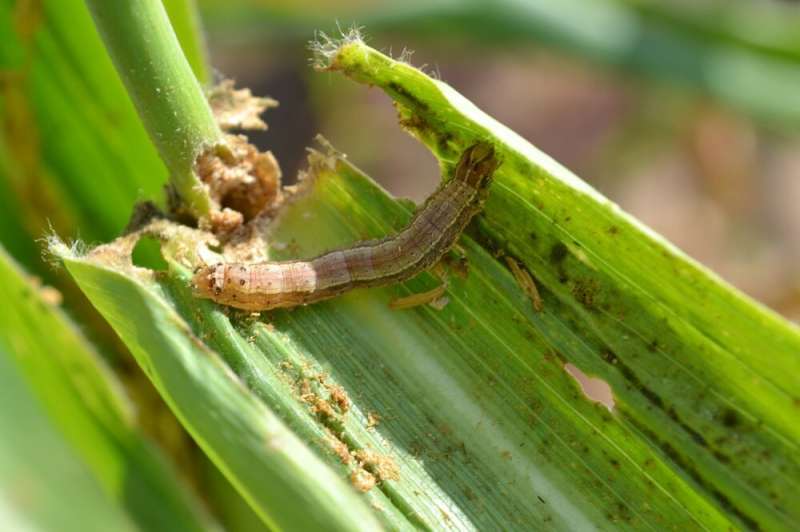Biopesticides should be preferred over chemical pesticides for fall armyworm control, study suggests

Safer-to-use and more environmentally-friendly biopesticides should be preferred to fight the fall armyworm (Spodoptera frugiperda) pest instead of more harmful chemical pesticides, a new CABI-led study published in the Journal of Pest Science suggests.
CABI scientists teamed up with colleagues from Ghana’s CSIR-Savanna Agricultural Research Institute (SARI), the University for Development Studies (UDS) and the Plant Protection and Regulatory Services Directorate (PPRSD) to investigate the effects of insecticides—including biopesticides—on the environment.
Specifically, the researchers conducted experiments both on-station in Wa and Nyankpala and on-farm in Wa during the 2020 rainy season to test the effect of commonly used biopesticides on fall armyworm in northern Ghana.
The fall armyworm is a highly destructive pest of cereals and has invaded Africa, parts of Asia and Australia over the past six years—threatening the food security and income of millions of smallholder farmers many of whom rely on maize as their staple crop.
While the outbreak of the pest in Africa has led to several recommendations of insecticides, including biopesticides, the effects of these products on the environment—especially parasitoids—have not been assessed under field conditions.
Active ingredients tested included neem oil (3% Azadirachtin), maltodextrin (282g/l), 55% Bacillus thuringienis (Bt) combined with 45% Monosultap, and a Pieris rapae granulosis virus combined with 5% Bt.
A chemical insecticide based on emamectin benzoate and acetamiprid was used as positive control while non-treated maize plots were considered as untreated control.
The two most abundant parasitoids in Wa were Coccygidium luteum and Chelonus bifoveolatus, while in Nyankpala they were C. luteum and Meteorus sp. Total larval parasitism rates on-station were 18.7% and 17.6% in Wa and Nyankpala, respectively, and 8.8% in Wa on-farm.
Dr. Lakpo Koku Agboyi, Project Manager—Invasive Species Management at CABI and lead author on the paper, said, “Untreated maize plots showed the highest larval density and plant damage, the highest cob damage, and generated the lowest yields. The other treatments showed hardly any difference in cob damage and yields, suggesting that biopesticides should be preferred over chemical pesticides for fall armyworm control.”
The researchers found that, in general, parasitism was lower in the maize fields treated with Ema Star and Bypel 1 as compared to untreated plots and those treated with other biopesticides, although the tendency was not consistently significant throughout the sites and dates.
This may be due the fact, the scientists suggest, that parasitoid complex varied with sites and dates and it is well known that different parasitoid species may react differently to pesticide and biopesticide treatments.
Another possible reason for the relatively low impact of pesticides and biopesticides on parasitism is the size of the plots and the ability of parasitoids to quickly move from adjacent, untreated fields or vegetation to the previously treated plots, they believe.
Dr. Jerry Nboyine, of the CSIR-SARI, said, “There was no consistent difference in cob damage and yields among the chemical pesticide and the biopesticides. In such situations, biopesticides should be preferred to minimize negative effects on human health, natural control and the environment in general.”
More information:
Lakpo Koku Agboyi et al, Comparative effects of biopesticides on fall armyworm management and larval parasitism rates in northern Ghana, Journal of Pest Science (2023). DOI: 10.1007/s10340-023-01590-z
Citation:
Biopesticides should be preferred over chemical pesticides for fall armyworm control, study suggests (2023, March 2)
retrieved 2 March 2023
from https://phys.org/news/2023-03-biopesticides-chemical-pesticides-fall-armyworm.html
This document is subject to copyright. Apart from any fair dealing for the purpose of private study or research, no
part may be reproduced without the written permission. The content is provided for information purposes only.
For all the latest Science News Click Here
For the latest news and updates, follow us on Google News.

